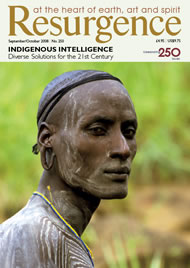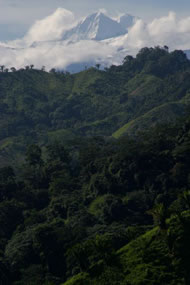NATURE AND CULTURE converge in many ways that span values, beliefs and norms to practices, livelihoods, knowledge and languages. As a result, there exists a mutual feedback between cultural systems and the environment, with a shift in one often leading to a change in the other. For example, knowledges evolve with the ecosystems upon which they are based, and languages contain words describing ecosystem components. If plants or animals are lost, then the words used to describe them are often lost shortly afterwards, and this changes the way the natural environment is shaped by the practices of those human communities. Nature provides the setting in which cultural processes, activities and belief systems develop, all of which feed back to shape biodiversity. There are four key bridges linking Nature with culture: beliefs and worldviews; livelihoods and practices; knowledge bases; and norms and institutions.
Beliefs and worldviews
Culture can be understood as systems by which people interpret the world around them. These meanings and interpretations are most diverse in their linkages to the natural world, with the most conspicuous links often found in traditional resource-dependent communities. Whereas many traditional communities do not seem to differentiate between Nature and culture, many modern societies perceive them as separate or even opposing entities. E. O. Wilson, however, has said that all humans, no matter their culture, have an innate connection with Nature based on our common histories as hunter-gatherers and agriculturalists (the biophilia hypothesis). With the coming challenges of climate change and peak oil, it is conceivable that those with industrialised livelihoods may have to undergo substantial transitions in the near future.
Livelihoods and practices
As a set of practices, cultures shape biodiversity through the selection of plants and animals and the reworking of whole landscapes. Such landscapes have been described as anthropogenic Nature, as their composition is a reflection of local culture and a product of human history. Growing archaeological and ethnographic evidence tells us that many habitats previously thought to be pristine are in fact an emergent property of resource-dependent livelihood practices. For instance, some North American landscapes were sustained through periodic burning and grazing regimes. These landscapes represent ecological profiles shaped by localised cultural practices. This has now been acknowledged with the naming of our era as the anthropocene.
This has led, amongst other things, to a split in attitudes to the concept of wilderness. Some wilderness societies are passionate advocates of its values (often without a clear idea of the role of traditional societies in shaping the ecology), while for traditional societies the term often causes anger because of the implication that traditional societies played no role in the shaping of their ancestral landscapes.
Knowledges about Nature
If diverse cultural practices and worldviews are central to the management of biological diversity, then the key link between Nature and culture is knowledge. How people know the world governs behaviours, understandings and values that shape human interactions with Nature. Knowledge of Nature, variously called traditional, Indigenous, local or ecological, is accumulated within a society and transferred through cultural modes of transmission such as stories and narratives. Cultural understandings of the environment not only give rise to sustainable management practices, but also to knowledge of species requirements, ecosystem dynamics, sustainable harvesting and ecological interactions. This culturally engrained knowledge can enable people to live within the constraints of their environment in the long-term.
Norms and institutions
Ecological knowledge also gives rise to socially embedded norms and regulations. These govern human interactions and behaviours towards the natural environment, and have often co-evolved to sustain both people and Nature. They often take the form of common property rules that govern the use of resources from forests to fisheries. These rules define access rights and appropriate behaviours, and maintain the productivity and diversity of socio-ecological systems – which is ultimately in the best interests of the community.
There has been an unparalleled shift towards both landscape and human monocultures in recent years, and many of the reasons are common. Some pressures have arisen from capitalist economies that stress unrestrained economic growth. The result is a shift in consumption patterns, even in traditional societies that interact with the capitalist economy, the globalisation of food systems, and the commodification of natural resources. These pressures are at their most damaging when they lead to rapid and unanticipated periods of socio-economic change, which jeopardises both cultural and ecosystems resilience. They are also likely to have destructive health outcomes, particularly for young people if they spend less time in Nature. Time spent directly experiencing Nature improves psychological health and wellbeing, as well as increasing physical activity levels. But disconnection leads to feelings of biophobia and a fear of the outdoors, perceiving it to be a wild and unfamiliar environment. This extinction of experience seems to be producing a new lost generation who are disconnected to any place in particular and unable to feel innate relationships with Nature.
These pressures are also paving the way to wider cultural monocultures, as a result of cultural extinctions caused by assimilation, language loss and knowledge loss. Rural communities are migrating to urban areas, cultural knowledge transmission between generations is declining, oral knowledge is being replaced with written knowledge (just as classrooms are replacing direct experience), and traditional livelihoods are being replaced by modern occupations, all at the expense of cultural diversity. This comes at a cost to human societies as a decline in knowledge causes a decline in the possible solutions that humanity holds to future global challenges.
THE NEED FOR effective policies in biodiversity protection has long been understood. But the importance of cultural protection is only just emerging. Since many common drivers exist between biological and cultural diversity, policies should now target both in a new approach for conservation. Locally, efforts could include local recovery projects, revitalisation schemes, culturally appropriate education schemes, and language revitalisation. Other approaches include the revival of culturally appropriate healthcare systems, the protection and careful commercialisation of traditional food systems, and the greening of businesses.
Larger-scale movements include fair trade and the recognition of land rights so that the integral relations between Nature and culture can be realised. Investment into community-based conservation and the dissemination of power to grassroots initiatives and institutions can strengthen mechanisms that favour social and environmental sustainability.
To conserve global diversity effectively, policy efforts need to be internationally driven, geographically targeted, multi-level and inclusive. Policies emphasising political empowerment, self-governance and territorial control at grassroots levels have the potential to provide a solid platform from which communities can play a central role in biodiversity conservation whilst retaining their own cultural distinctiveness and connectedness to the land.
The degree to which the diversity of the world’s ecosystems, upon which we as humans depend, is linked to the diversity of its cultures is only beginning to be understood. Ironically, it is precisely as we come to understand this linkage that many cultures are receding towards extinction. •








